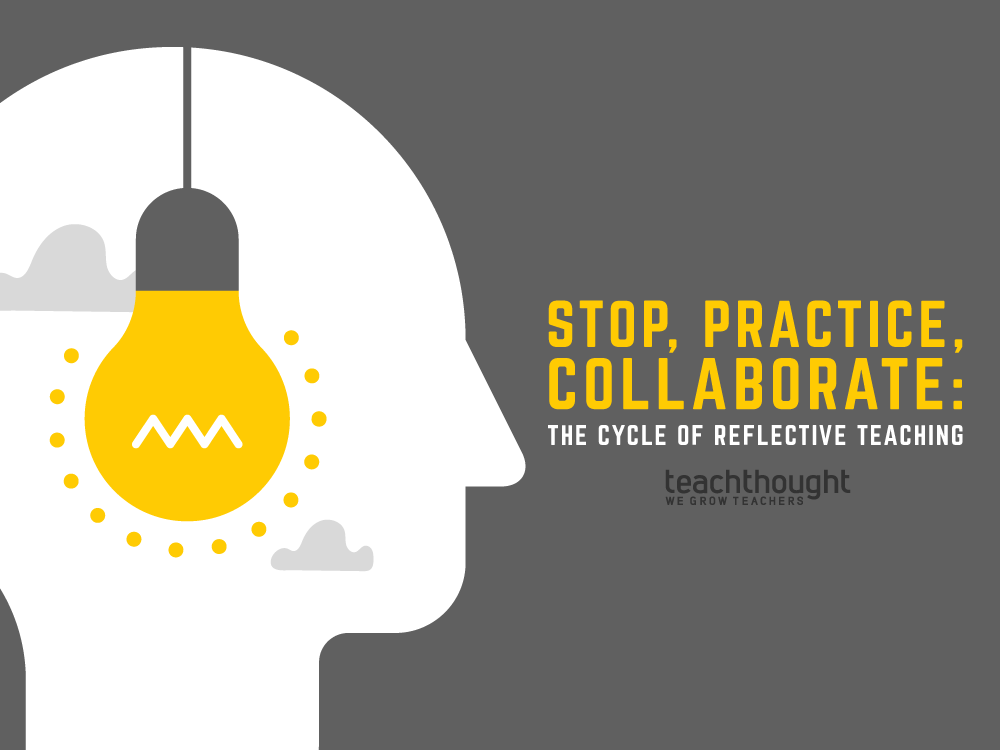
contributed by Pete Hall and Alisa Simeral
This post has been updated and republished
The more reflective you are, the more effective you are.
This is a phrase that has become synonymous with the work we have done with building teachers’ reflective capacity. With a century’s worth of research touting the benefits of self-reflection and a slew of tools to help teachers (and the coaches and administrators who support them) strengthen their reflective habits, the causative relationship between the two is growing more evident.
People often ask us, “If self-reflection is a skill that can be developed, how exactly am I supposed to develop it?” Fortunately, with the release of Teach, Reflect, Learn: Building Your Capacity for Success in the Classroom, we have provided hundreds of reflective prompts and dozens of strategies. Here’s a cheat-sheet: 3 steps we can all take to build our self-reflective habits.
Stop, Practice, Collaborate: The Cycle Of Reflective Teaching
Step 1: Stop
Have you ever heard someone say, “Well, I never really stopped to think about it.” More than likely, you’ve muttered that phrase yourself. We tend to get so caught up in the here and now, busy hustling from task to task, drowning in our to-do lists, that we find ourselves too deep in our routines to see beyond the ruts. We’re doing without really thinking about what we’re doing.
This is the cause of what we’ve come to call the doing-thinking gap. As a teacher, you do a thousand things a day – it’s high time that you stopped, took stock in what you’re doing, why you’re doing it, and how it’s going. It’s a cycle, which means it can be practiced and refined.
Step 2: Practice
Thinking about your work, as an act unto itself, will not singlehandedly make you a more reflective and effective educator. It is a necessary, though not sufficient, activity. How you reflect, and what you reflect about, will provide structure to this thinking strategy. In T, R, L, we share the Reflective Cycle – four key steps that usher you along the path to deeper self-reflection.
If you center your reflective practices on these four, you’ll reap the dividends:
1. Awareness
Reflective practitioners are aware of their instructional reality. That means they know their students, their content, and the high-leverage pedagogy that leads to higher levels of learning. So pay attention to everything, pick up the details, look for opportunities to connect the three together.
2. Intentionality
You may have heard some variation of the saying, “Excellence is not happenstansical.” Greatness is born from intentionality and planning. Everything a reflective teacher does is selected on purpose, to achieve a certain outcome, and is planned and executed deliberately. Emphasis here addresses the why you are doing things.
If a teacher uses strategy x to accomplish outcome y, then it would make sense for that teacher to determine if it worked. Reflective practitioners assess the results of their work all the time, constantly determining the effectiveness and shortcomings of their efforts. Deeper reflection leads to an analysis of why certain teaching moves worked and others didn’t.
4. Responsiveness
Building off the assessment step, reflective teachers take action – if strategy x didn’t achieve outcome y to the degree needed, the teacher does something about it. Modifying lesson designs, providing reviews, delivering in-the-moment clarifications, and constructing intervention plans are all examples of how teachers can be responsive to that assessment.
Step 3: Collaborate
This work is far too complex, and far too important, to go it alone. In our first book, Building Teachers’ Capacity for Success: A Collaborative Approach for Coaches and School Leaders, we offered a coaching model and tools for administrators to ‘talk teaching’ with their teachers. Now, we invite teachers to partner with their colleagues, create a network of reflective practitioners, and take the reins of their own reflective professional growth.
It’s amazing what we can accomplish when we put our heads together.
Pete Hall (@educationhall) is a veteran school administrator and professional development agent who has dedicated his career to supporting the improvement of our education systems. His is currently a faculty member with ASCD Professional Learning Services. Alisa Simeral (@AlisaSimeral) is a school turnaround specialist and veteran educator who has guided school-based reform efforts as a teacher, dean, and instructional coach. Together, they are co-authors of the new book, Teach, Reflect, Learn: Building Your Capacity for Success in the Classroom (ASCD); The Cycle Of Reflective Teaching




